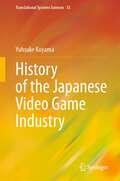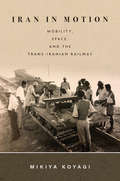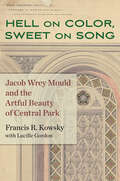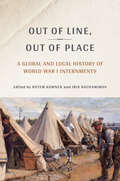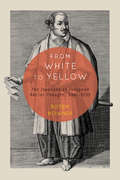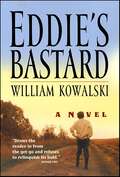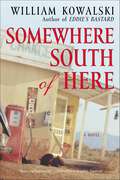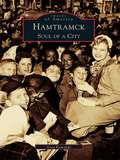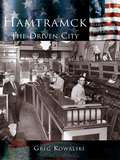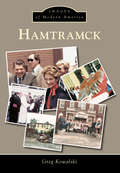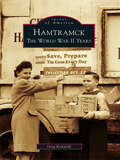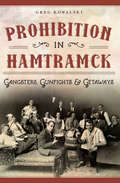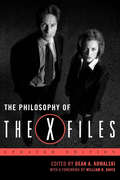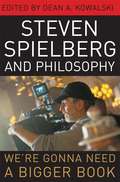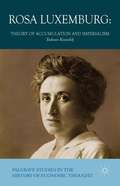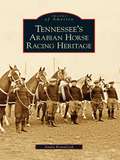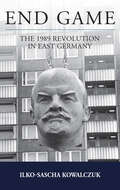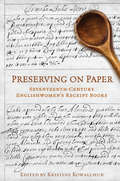- Table View
- List View
History of the Japanese Video Game Industry (Translational Systems Sciences #35)
by Yusuke KoyamaThis book is the first one to describe the entire history of the video game industry in Japan. The industry consists of multiple markets—for PCs, home consoles, arcades, cellular phones and smart phones—and it is very difficult to see the complete picture. The book deals comprehensively with the history of the Japanese game industry from the beginning of the non-computer age to the present. The video game industry in Japan was established in the arcade game market when Space Invaders was released by Taito in 1978. Game markets for both PCs and home consoles followed in the early 1980s. The platform that occupies a central market position started with the arcade and shifted, in order, to the home console, handheld consoles, and smart phones. In the video game industry in the twentieth century each platform had a clear identity, and the relationships among platforms were "interactions". In the twenty-first century, with the improvement of computer performance, the platform identity has disappeared, thus the relationship among platforms is highly competitive. Since the "crash of 1983" in the United States, the Japanese game industry has one of the largest market shares in the world and has developed without being influenced by other countries. It reached its peak in the late 1990s, and then its relative position declined due to the growth of foreign markets and the failure of emerging markets such as online PC games. Even today, Japan's gaming industry holds a dominant position in the world, but it is not the superpower it once was. Since the beginning of the twenty-first century, game research has become active worldwide. Among game researchers, there is a large demand for research on games in Japan, but there is still little dissemination of research in English. The original version of this book published in Japan is highly regarded and received an award for excellence from the Society of Socio-Informatics in 2017.
Iran in Motion: Mobility, Space, and the Trans-Iranian Railway
by Mikiya KoyagiCompleted in 1938, the Trans-Iranian Railway connected Tehran to Iran's two major bodies of water: the Caspian Sea in the north and the Persian Gulf in the south. Iran's first national railway, it produced and disrupted various kinds of movement—voluntary and forced, intended and unintended, on different scales and in different directions—among Iranian diplomats, tribesmen, migrant laborers, technocrats, railway workers, tourists and pilgrims, as well as European imperial officials alike. Iran in Motion tells the hitherto unexplored stories of these individuals as they experienced new levels of mobility. Drawing on newspapers, industry publications, travelogues, and memoirs, as well as American, British, Danish, and Iranian archival materials, Mikiya Koyagi traces contested imaginations and practices of mobility from the conception of a trans-Iranian railway project during the nineteenth-century global transport revolution to its early years of operation on the eve of Iran's oil nationalization movement in the 1950s. Weaving together various individual experiences, this book considers how the infrastructural megaproject reoriented the flows of people and goods. In so doing, the railway project simultaneously brought the provinces closer to Tehran and pulled them away from it, thereby constantly reshaping local, national, and transnational experiences of space among mobile individuals.
Hell on Color, Sweet on Song: Jacob Wrey Mould and the Artful Beauty of Central Park
by Francis R. KowskyReveals new and previously unknown biographical material about an important figure in nineteenth-century American architecture and music.Jacob Wrey Mould is not a name that readily comes to mind when we think of New York City architecture. Yet he was one-third of the party responsible for the early development of the city’s Central Park. To this day, his sculptural reliefs, tile work, and structures in the Park enthrall visitors. Mould introduced High Victorian architecture to NYC, his fingerprint most pronounced in his striking and colorful ornamental designs and beautiful embellishments found in the carved decorations and mosaics at the Bethesda Terrace. Resurfacing the forgotten contributions of Mould, Hell on Color, Sweet on Song presents a study of this nineteenth-century American architect and musical genius.Jacob Wrey Mould, whose personal history included a tie to Africa, was born in London in 1825 and trained there as an architect before moving to New York in 1852. The following year, he received the commission to design All Souls Unitarian Church. Nicknamed “the Church of the Holy Zebra,” it was the first building in America to display the mix of colorful materials and medieval Italian inspiration that was characteristic of High Victorian Gothic architecture. In addition to being an architect and designer, Mould was an accomplished musician and prolific translator of opera librettos. Yet anxiety over money and resentment over lack of appreciation of his talents soured Mould’s spirit. Unsystematic, impractical, and immune from maturity, he displayed a singular indifference to the realities of architecture as a commercial enterprise. Despite his personal shortcomings, he influenced the design of some of NYC’s revered landmarks, including Sheepfold, the Metropolitan Museum of Art, the American Museum of Natural History, the City Hall Park fountain, and the Morningside Park promenade. From 1875 to 1879, he worked for Henry Meiggs, the “Yankee Pizarro,” in Lima, Peru.Resting on the foundation of Central Park docent Lucille Gordon’s heroic efforts to raise from obscurity one of the geniuses of American architecture and a significant contributor to the world of music in his time, Hell on Color, Sweet on Song sheds new light on a forgotten genius of American architecture and music.Funding for this book was provided by: Furthermore: a program of the J. M. Kaplan Fund
Out of Line, Out of Place: A Global and Local History of World War I Internments
by Rotem Kowner Iris RachamimovWith expert scholars and great sensitivity, Out of Line, Out of Place illuminates and analyzes how the proliferation of internment camps emerged as a biopolitical tool of governance. Although the internment camp developed as a technology of containment, control, and punishment in the latter part of the nineteenth century mainly in colonial settings, it became universal and global during the Great War.Mass internment has long been recognized as a defining experience of World War II, but it was a fundamental experience of World War I as well. More than eight million soldiers became prisoners of war, more than a million civilians became internees, and several millions more were displaced from their homes, with many placed in securitized refugee camps. For the first time, Out of Line, Out of Place brings these different camps together in conversation. Rotem Kowner and Iris Rachamimov emphasize that although there were differences among camps and varied logic of internment in individual countries, there were also striking similarities in how camps operated during the Great War.
From White to Yellow
by Rotem KownerWhen Europeans first landed in Japan they encountered people they perceived as white-skinned and highly civilized, but these impressions did not endure. Gradually the Europeans' positive impressions faded away and Japanese were seen as yellow-skinned and relatively inferior. Accounting for this dramatic transformation, From White to Yellow is a groundbreaking study of the evolution of European interpretations of the Japanese and the emergence of discourses about race in early modern Europe. Transcending the conventional focus on Africans and Jews within the rise of modern racism, Rotem Kowner demonstrates that the invention of race did not emerge in a vacuum in eighteenth-century Europe, but rather was a direct product of earlier discourses of the "Other." This compelling study indicates that the racial discourse on the Japanese, alongside the Chinese, played a major role in the rise of the modern concept of race. While challenging Europe's self-possession and sense of centrality, the discourse delayed the eventual consolidation of a hierarchical worldview in which Europeans stood immutably at the apex. Drawing from a vast array of primary sources, From White to Yellow traces the racial roots of the modern clash between Japan and the West.
From White to Yellow: The Japanese in European Racial Thought, 1300-1735 (McGill-Queen's Studies in the History of Ideas #63)
by Rotem KownerWhen Europeans first landed in Japan they encountered people they perceived as white-skinned and highly civilized, but these impressions did not endure. Gradually the Europeans' positive impressions faded away and Japanese were seen as yellow-skinned and relatively inferior. Accounting for this dramatic transformation, From White to Yellow is a groundbreaking study of the evolution of European interpretations of the Japanese and the emergence of discourses about race in early modern Europe. Transcending the conventional focus on Africans and Jews within the rise of modern racism, Rotem Kowner demonstrates that the invention of race did not emerge in a vacuum in eighteenth-century Europe, but rather was a direct product of earlier discourses of the "Other." This compelling study indicates that the racial discourse on the Japanese, alongside the Chinese, played a major role in the rise of the modern concept of race. While challenging Europe's self-possession and sense of centrality, the discourse delayed the eventual consolidation of a hierarchical worldview in which Europeans stood immutably at the apex. Drawing from a vast array of primary sources, From White to Yellow traces the racial roots of the modern clash between Japan and the West.
The Impact of the Russo-Japanese War (Routledge Studies in the Modern History of Asia #10)
by Rotem KownerThe Russo-Japanese War was the major conflict of the earliest decade of the twentieth century. The struggle for mastery in northeast Asia, specifically for control of Korea, was watched at the time very closely by observers from many other countries keen to draw lessons about the conduct of war in the modern industrial age. The defeat of a traditional European power by a non-white, non-western nation became a model for imitation and admiration among people under, or threatened with, colonial rule. Examining the wide impact of the war and exploring the effect on the political balance in northeast Asia, this book focuses on the reactions in Europe, the United States, East Asia and the wider colonial world, considering the impact on different sections of society, on political and cultural ideas and ideologies, and on various national independence movements.
Simonides on the Persian Wars: A Study of the Elegiac Verses of the "New Simonides" (Studies in Classics)
by Lawrence M. KowerskiThis book considers what evidence the "new Simonides" fragments offer for Simonides' elegiac compositions on the Persian Wars. The current orthodoxy is that they represent three separate elegies on individual battles, one on Artemisium, one on Salamis, and one on Plataea. Kowerski evaluates what evidence these fragments provide for these compositions, and in doing so, questions the validity of the current interpretation of the "new Simonides."
Eddie's Bastard: A Novel
by William Kowalski"Eddie's Bastard" is William Amos Mann IV, known as Billy -- the son of a heroic pilot killed in Vietnam and an unknown woman. The last in a line of proud, individualistic Irish-American men, Billy is discovered in a basket at the door of the dilapidated mansion where his bitter, hard-drinking grandfather, Thomas Mann, has exiled himself. Astonished and moved by the arrival of his unexpected progeny, Thomas sets out to raise the boy himself -- on a diet of love, fried baloney, and the fascinating lore of their shared heritage. Listening to his sets out to capture the stories on paper. He is a Mann, Grandpa reminds him daily, and thus destined for greatness. Through the tales of his ancestors, his own experiences, and the unforgettable characters who enhance and enliven his adolescence, Billy learns of bravery and cowardice, of life and death, of the heart's capacity for love and for unremitting hatred, eventually grasping the meaning of family and history and their power to shape destiny. Steeped in imagery and threaded with lyricism, Eddie's Bastard is a novel of discovery, of a young man's emergence into the world, and the endless possibilities it offers.
Somewhere South of Here: A Novel
by William KowalskiI'd wondered about my mother all my life -- what she looked like, how she smelled and sounded and acted. Lately this wondering had grown to encompass a curiosity about the kind of people she herself came from, because they were my family, too, after all, even though I knew nothing about them. I'd no idea whether they were loud or soft-spoken, funny or boring, preferred chocolate to vanilla, if they liked movies over books or the other way around. I wondered whether any of them had ever done anything magnificent in their lives, or if they were the kind of folks who were satisfied with just getting by. These things were important -- knowing them would help me to know myself, and the only way that would happen was if I went and looked for her.With all his possessions on his motorcycle, Billy Mann sets off on a cross-country odyssey from New York to Santa Fe in search of a mother who deserted him long ago. What Billy discovers, however, is a life rich with possibility -- the chance for love, friendship, and, finally, a family to call his own.
The Russian Revolution: 1917-1921 (Routledge Sources in History)
by Ronald KowalskiThe collapse of the Soviet Union in 1991 has provided fresh perspectives from which to view the Revolution out of which it grew. The Russian Revolution, 1917-1921, by Ronald Kowalski, reviews the ever-changing debate on the nature of the Russian Revolution. This collection of documents and sources includes: * newspapers, memoirs and literature * commentary and background information of each source * a narrative of the major events of the period * new material made available since the policy of glasnost * a re-examination of World War One and the Revolution * focus on thematic issues such as the actions of peasants and workers. For students of European history this will provide interesting and informative reading on this major event in Russia's turbulent past.
Hamtramck: Soul of a City
by Greg KowalskiSince its founding in 1798, the city of Hamtramck, Michigan has evolved from a dusty farming community on the edge of Detroit into a nationally recognized town of culture and character. The Dodge Main factory, founded in 1910, drew thousands of immigrants to the city of Hamtramck, and a vibrant, multi-cultural community began to grow. Over the course of the next 90 years, the people of Hamtramck developed a landmark educational system, a strong devotion to church and family, a fiery political scene, and labor-organizing activities with national reverberations. In this book, author Greg Kowalski uses a unique collection of historical photographs to document Hamtramck's incredible growth throughout the years, and reveal the unmatched integrity, commitment, and independence of its people.
Hamtramck: The Driven City
by Greg KowalskiSurrounded completely by the city of Detroit, Hamtramck is today home to 24,000 residents, but its small size-just 2.1 square miles-belies its expansive history and the influence this remarkable community has had far beyond its borders.Founded as a township in 1798, Hamtramck remained primarily a rural area until the early twentieth century, when auto pioneers John and Horace Dodge opened a factory on the south end of town. In just 20 years, the city's population increased by a staggering 1,600 percent. The majority of these newest residents were Polish immigrants, who brought with them a strong work ethic, a rich culture, a genuine joy for living, and an intense appreciation for democracy. Legendary to this day for its fiery politics, the solidly Democratic Hamtramck openly flaunted Prohibition, received a visit from President Franklin D. Roosevelt, strongly supported the early labor unions, and even served as a key headquarters for the Communist Party in North America. In Hamtramck: The Driven City, an engaging narrative combined with more than 100 black-and-white images will take readers on a fascinating journey into the past and breathe new life into the memorable characters and events, the conflicts and scandals that formed the city's distinctive identity.
Hamtramck: The Driven City (Images of Modern America)
by Greg KowalskiFew towns in America have undergone a transformation like Hamtramck. From a farming community of 3,500 people in 1910, it became an industrial powerhouse of 48,000 by 1920. Much of that early history is gone, but much remains-some remnants of an age of iron and smoke and some transformed into buildings with a functional modern use.
Hamtramck: The World War II Years (Images of America)
by Greg KowalskiWith a population made up overwhelmingly of Polish immigrants and descendents of Poles, Hamtramck was especially hardhit by the impact of World War II. Most of the city's residents had family contacts with the old country. When Germany invaded Poland on September 1, 1939, Hamtramckans reacted with shock and anger--and with a determination to see fascism defeated and Poland freed. Thousands of Hamtramckans fought in the war, hundreds died. And those who remained at home dealt with the wartime life as best they could. Hamtramck: The World War II Years presents a portrait of the city at war. It tells and shows how Hamtramckans--of all ages, races, and backgrounds--coped with shortages, the threat of attack, and the everpresent dread that the next telegram may bring news of a soldier's death. It was a challenging time that demanded strength, dedication, and sacrifice. Hamtramckans stood up and delivered all that was required--and more.
Murder in Hamtramck: Historic Crimes of Passion & Coldblooded Killings (True Crime)
by Greg KowalskiFounded in 1798, Hamtramck shrank in size even as it grew in population. Stuffing tens of thousands of people in 2.1 square miles is bound to breed conflict, and many of those conflicts boiled over into murder. Sunday, September 7, 1884, was supposed to be a day of joy for Fritz Krum, whose child was being christened. Instead, it ended in a fatal stabbing. The 1930 killing of police officer Barney Roth in a reputed mob hit drew national attention. The murder of Hamtramck teen Bernice Onisko remains an open case today, more than eighty years after it occurred. Gathering cases from the late nineteenth century to more recent times, prolific local historian Greg Kowalski takes readers on a journey through Hamtramck homicide.
Prohibition in Hamtramck: Gangsters, Gunfights & Getaways (American Palate)
by Greg KowalskiThe National Prohibition Act was no match for Hamtramck. Once a small farming village, Hamtramck grew to be a major industrial city in just a decade. With that came enormous social problems and a peculiar concept that the legality of alcohol wasn't a constraint but, rather, an opportunity. Flaunting the infamous law became a way of life in Hamtramck, where it was as easy to get a drink as an ice cream cone. Paddy McGraw proudly ran his speakeasy and brothel with impunity. Mayors Peter Jezewski and Rudolph Tenerowicz were sent to prison for violations but were rewarded by the public. Join author Greg Kowalski as he delves into Hamtramck's raucous prohibition history.
Wicked Hamtramck: Lust, Liquor and Lead (Wicked)
by Greg KowalskiHamtramck's population bulged to 56,000 from a mere 3,500 in the early twentieth century, a sixteen-fold increase that created the perfect environment for crime and corruption to flourish. Post-Prohibition, bars sprang up in quick order, until there were at least two hundred within this wide-open town's 2.1 square miles, giving it more bars per capita than any other city in America; even the Dodge brothers served barrels of beer to their workers. Follow local historian Greg Kowalski through the underbelly of Hamtramck, from the "painted women openly flaunting their tainted charms from undraped windows" to the nefarious plots crafted behind the walls of the International Workers Home on Yemens Street. Welcome to the height of Hamtramck's infamy, where anything could happen--for a price.
The Philosophy of The X-Files: Updated Edition (The Philosophy of Popular Culture #Ppcs)
by Dean A. KowalskiIn The Philosophy of The X-Files, Dean A. Kowalski has gathered a remarkable cast of contributors to shed light on the philosophical mysteries of the television show The X-Files. With sections devoted to the show's credos, such as "The Truth Is Out There," individual characters, and specific episodes, The Philosophy of The X-Files illuminates the philosophical assumptions and presuppositions of the show as well as presents discussions through the show to help the reader better understand philosophy and philosophical inquiry.
Steven Spielberg and Philosophy: We're Gonna Need a Bigger Book
by Dean A. KowalskiHas any film director had a greater impact on popular culture than Steven Spielberg? Whether filming Holocaust heroes and villains, soldiers, dinosaurs, extraterrestrials, or explorers in search of the Holy Grail, Spielberg has given filmgoers some of the most memorable characters and wrenching moments in the history of cinema. Whatever his subject -- war, cloning, slavery, terrorism, or adventure -- all of Spielberg's films have one aspect in common: a unique view of the moral fabric of humanity. Dean A. Kowalski's Steven Spielberg and Philosophy is like a remarkable conversation after a night at the movie theater, offering new insights and unexpected observations about the director's most admired films. Some of the nation's most respected philosophers investigate Spielberg's art, asking fundamental questions about the nature of humanity, cinema, and Spielberg's expression of his chosen themes. Applying various philosophical principles to the movies, the book explores such topics as the moral demands of parenthood in War of the Worlds; the ultimate unknowability of the "other" in Close Encounters of the Third Kind and Schindler's List; the relationship between nature and morality in Jurassic Park; the notion of consciousness in A. I. : Artificial Intelligence; issues of war theory and ethics in Munich; and the foundation of human rights in Amistad. Impressive in scope, this volume illustrates the philosophical tenets of a wide variety of thinkers from Plato to Aquinas, Locke, and Levinas. Contributors introduce readers to philosophy while simultaneously providing deeper insight into Spielberg's approach to filmmaking. The essays consider Spielberg's movies using key philosophical cornerstones: metaphysics, epistemology, ethics, axiology, aesthetics, and political philosophy, among others. At the same time, Steven Spielberg and Philosophy is accessible to those new to philosophy, using the philosophical platform to ponder larger issues embedded in film and asking fundamental questions about the nature of cinema and how meanings are negotiated. The authors contend that movies do not present philosophy -- rather philosophy is something viewers do while watching and thinking about films. Using Spielberg's films as a platform for discussing these concepts, the authors contemplate questions that genuinely surprise the reader, offering penetrating insights that will be welcomed by film critics, philosophers, and fans alike.
The Company of the Dead
by David KowalskiCan one man save the Titanic? March 1912. A mysterious man appears aboard the Titanic on its doomed voyage. His mission? To save the ship. The result? A world where the United States never entered World War I, thus launching the secret history of the 20th Century.April 2012. Joseph Kennedy - grand-nephew of John F. Kennedy - lives in an America occupied in the East by Greater Germany and on the West Coast by Imperial Japan. He is one of six people who can restore history to its rightful order -- even though it would mean his own death."A magnificent alternate history, set against the backdrop of one of the the greatest maritime disasters." Library Journal"Imaginative, monolithic, action-packed... The reader will not be disappointed." -- Bookseller and Publisher "Time travel, airships, the Titanic, Roswell ... Kowalski builds a decidedly original creature that blends military science fiction, conspiracy theory, alternate history, and even a dash of romance." Publishers Weekly "Kowalski effortlessly smashes together high art and grand adventure in this alt-history juggernaut." John Birmingham, acclaimed author of Weapons of Choice "Exciting action, twisty and ingenious characterisation, and complicated time-travel plotting, deftly handled." S.M. Stirling, NYT bestselling author of The Tears of the Sun "A non-stop chase that takes place across two thousand miles ... and one hundred years of perdurant time." Walter Jon Williams, NYT bestselling author of Deep State
Rosa Luxemburg
by Tadeusz KowalikThis translated volume of Tadeusz Kowalik's Rosa Luxemburg examines the theorist's contribution to economic theory. Part I discusses the dependence of capital accumulation on effective demand and also on specific capitalist barriers to growth. Part II is devoted to the relationship between capital accumulation and economic (and political) imperialism. Luxemburg's analysis is contrasted to the underconsumptionist theory of capitalist crisis that prevailed among her critics. Although Kowalik recognizes Luxemburg's analysis as incomplete, he argues that she correctly identified the realization of surplus as the key constraint on expanded production in capitalism. This then points to a reinterpretation of Kalecki and Keynes, placing their analyses in a clear line of descent from Marx. Kalecki's analysis of militarism neatly complements Luxemburg's analysis, while Kowalik identifies neo-colonialism as a type of Luxemburg imperialism, providing markets that allow for the realisation of profits in the advanced capitalist countries. Toporowski and Szymborska's accessible translation of Tadeusz Kowalik's masterpiece will appeal to professional economists, scholars, researchers and students of the history of economic thought and economic theory.
Tennessee's Arabian Horse Racing Heritage
by Andra KowalczykHistorically Tennessee's horse breeding industry has received recognition for producing prized Thoroughbred racehorses, smooth-gaited Tennessee Walking horses, and sturdy work mules. Historical accounts, however, largely overlook the contributions of Tennessee horse breeders to the sport of Arabian horse racing. One hundred years have passed since anti-gambling legislation ended Tennessee's reign over the "sport of kings," Thoroughbred horse racing. However, the state has figured prominently in the development of Arabian horse racing. Leading up to the inaugural race event in 1959, and in more recent years as the amateur recreation became a bona fide sport, Tennesseans have had a calculable effect on the creation and advancement of Arabian horse racing in the United States.
End Game: The 1989 Revolution in East Germany (Studies in German History #26)
by Ilko-Sascha KowalczukThe fall of the Berlin Wall, and the chain of events leading up to it, arguably constitute one of the most thoroughly documented episodes in recent history. Nonetheless, most accounts have focused predominantly on high-level politics and diplomacy along with the most dramatic and photogenic public displays. End Game, a rich, sweeping account of the autumn of 1989 as it was experienced “on the ground” in the German Democratic Republic, powerfully depicting the desolation and dysfunction that shaped everyday life for so many East Germans in the face of economic disruption and political impotence. Citizens’ frustration mounted until it bubbled over in the form of massive demonstrations and other forms of protest. Following the story up to the first free elections in March 1990, the volume combines abundant detail with sharp analysis and helps us to see this familiar historical moment through new eyes.
Preserving on Paper: Seventeenth-Century Englishwomen's Receipt Books
by Kristine KowalchukApricot wine and stewed calf’s head, melancholy medicine and "ointment of roses." Welcome to the cookbook Shakespeare would have recognized. Preserving on Paper is a critical edition of three seventeenth-century receipt books–handwritten manuals that included a combination of culinary recipes, medical remedies, and household tips which documented the work of women at home. Kristine Kowalchuk argues that receipt books served as a form of folk writing, where knowledge was shared and passed between generations. These texts played an important role in the history of women’s writing and literacy and contributed greatly to issues of authorship, authority, and book history. Kowalchuk’s revelatory interdisciplinary study offers unique insights into early modern women’s writings and the original sharing economy.
